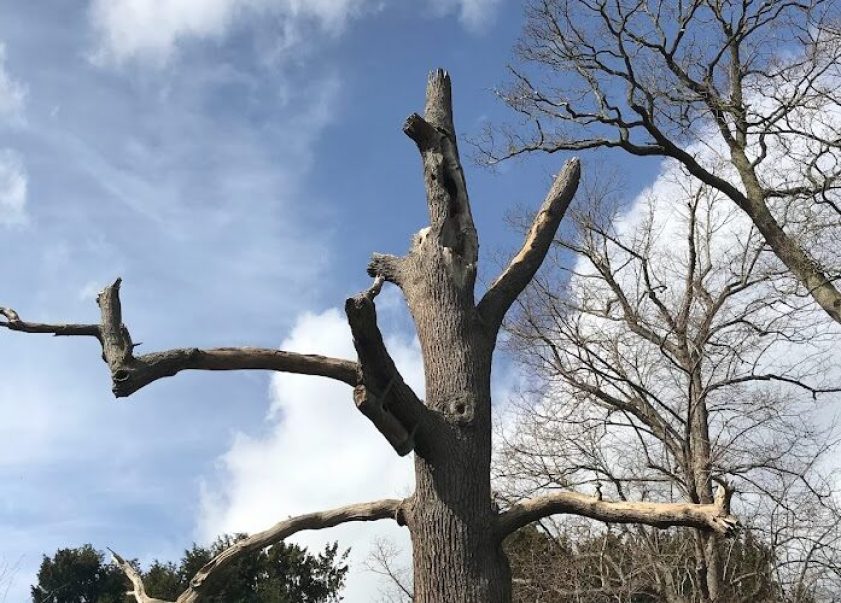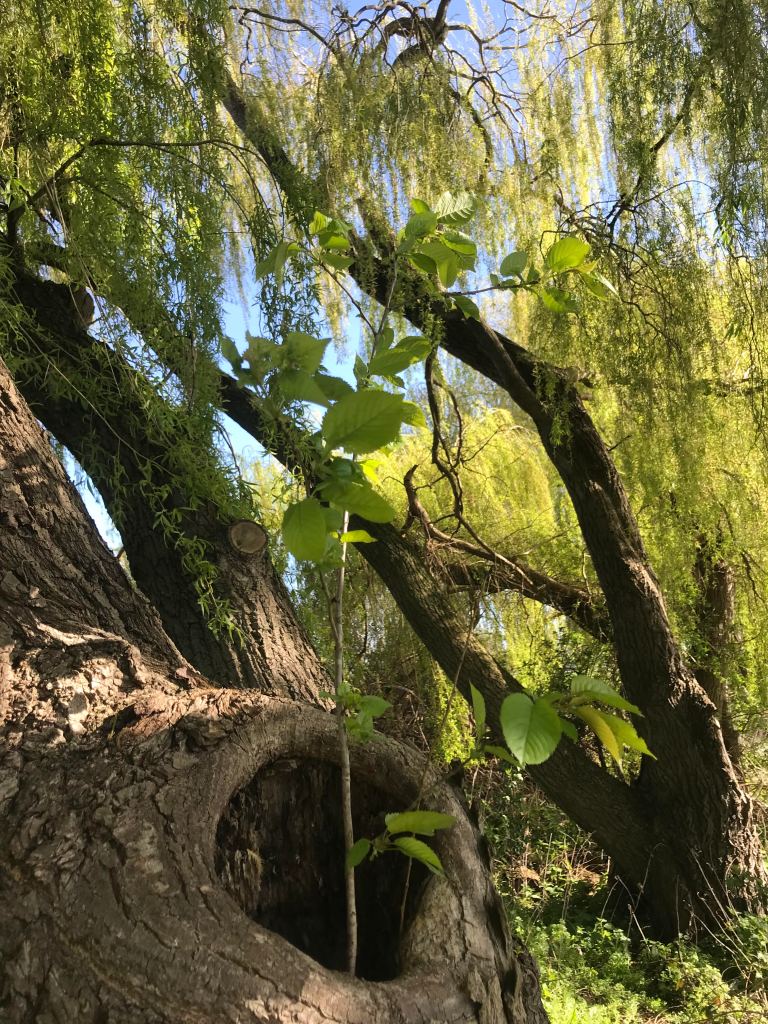
Spear Coppicing: A Slow, Beautiful Decay for your Trees
- by Admin
- Posted on April 14, 2023
Have you got your landscaping eye on a tree in the garden but you’ve been hesitating on where to go with it? Well may I introduce the practice of Spear Coppicing to you? If you’re handy with a saw & ladder, it’s a way to turn a tree into a prominent wildlife feature, and cut back on the annual foliage. Over time the tree will become standing deadwood and become inhabitable to multiple birds, beetles, fungi, and small mammals. It remains strong & firm for far longer than most other naturally occurring dead trees whom mostly rot from the base up, as it will deteriorate from the uppermost branches downward.
Interested? Well let’s get cracking!
Standard Coppicing
I’ve spoken & explained coppicing before, with it being an ancient (pre recorded history) method of woodland management for various reasons, but predominantly at the time for timber & firewood, and now it is now a prominent wildlife conservation technique for increasing biodiversity & habitat quality for species who struggle to find these now scarce habitats.
In the sense that opportunity for life comes from variety within habitats, coppicing involves felling a tree at it’s base to allows numerous new shoots to grow from the stump – it’s recognisable as have many thin “trunks” shooting upwards to a now sunny opening in the forest canopy. Another version is Pollarding, which involves cutting the branches of a tree to allow the same thing to occur, but at the canopy height.
Both are respected ways of improving the health & biodiversity of a forest by exposing the woodland ground flora to sunlight, whilst keeping other environmental features of a forest, and establishing a more complex habitat for the many plant species. In effect, you could see it as a replication of beavers munching a tree down, only for the tree to continue it’s life by growing new shoots & leaves from it’s base, or fallen yet still living trunk.
Lovely! Now, what is Spear Coppicing?
In the below photo a picture of a pollarded tree – a tree with it’s branches cut. What is different from the average coppicing/pollarding practice is the cross-section cuts into the main branches, creating an open lattice and exposing the inside of the wood to a greater degree. You’ll likely be able to see below the “teeth” that have been cut into the branches ends, creating what looks like pointed tips – the spears.

The purpose of these cross-cuts is to allow moisture from rain & humidity in the air to gather within the trees extremities. Over time we would see the beginnings of rot as the tree slowly breaks down from it’s ends inwards. Eventually, the tree will die, yet remain standing – known as Standing Deadwood, and deeply sought-after resource for much of our wildlife which I will discuss in a moment.
The essential difference in coppicing and spear-coppicing is that the former encourages rejuvenation whilst the latter encourages deterioration. Both are good alternatives for wildlife should you seek to offer something new from your selection of trees.
However just to address the elephant in the garden and provide some forewarning, by encouraging a tree to become standing deadwood it will become more liable to falling. This can be either it’s branches or it’s trunk due to the decay, and I would advise you avoid this practice if you aren’t confident of the initial cutting of the tree, or are wary of the risk/damage of falling wood. Perhaps aim for a tree in your garden that is already dead, and you would like to encourage further decay.
Why Encourage Deadwood?
Decomposing wood is part of every tree’s life cycle, and is essential to returning the vast & dense nutrients within it’s body to the surroundings. Throughout a trees decay, decomposition, and eventual death, the tree provides a nutrient-rich habitat for a variety of fungi, acts as a nursery for insects (especially beetles), and ergo a larder for insectivorous animals and birds.
By allowing this process to occur in your garden, it would feed the soils, plants, and wildlife in your garden for the duration of the tree’s decomposition, which in all likelihood is many years, offering you a long length of fertile soil and enjoyable wildlife sightings.
Standing and Fallen deadwood
The rarest of deadwood is a dead tree still standing,. Typically dead trees are weak to high winds and therefore are not common, yet those that remain in place offer a habitat for those that specialise this particular habitat. You may notice some very uncommon species making their home upon it. Living trees can even host deadwood, another natural lifecycle for trees, and occurs in branches, the trunk, or more commonly ion an event called Hollowing, within it’s Heartwood. The insides of a tree is referred to as the heartwood, and it is not alive, instead acting as a form of support for the weight of the tree. Trees can live a long time with actively decaying heartwood/limbs, with both the living and dying aspects of the wood supporting a wider array of species – even other plants when exposed;

In general, most deadwood comes in the shape of fallen branches, bark, or the entire tree itself, and even roots beneath the ground. Beyond this, wood felled by human hand is also fairly common in some areas. Regardless of the source, once the decay & decomposition begin, the dense reserves of nutrients are released into the soils over time, slowly feeding the surrounding wildlife. Interestingly, plants have naturally adapted to the rate at which wood releases it’s nutrients, ensuring they make the most of the opportunity to invest in long-term development rather than speedy growth (unless found by a particularly voracious species).
Negative Connotations
Several poor connotations have been linked to dead & decaying wood, especially from our vantage point as humans. Rotting logs, torn branches, and felled trunks are seen as unhealthy, unsafe or untidy, a mindset that is correct when we must determine the state of rot in enclosed spaces, or if we are worried about risk of falling branches. So, wisely, us humans have a tendency to “neaten” our surroundings in efforts to enjoy better health, lower risks, cleanliness, and beauty of scenery, yet for deadwood our behaviours ultimately reduces the availability of this resource to wildlife, and the environment.
In this theme, managers of any trees & woodlands must weigh the ecological value of deadwood against the safety risk that is presented. Often it is the safety of people that is the final decision, a choice I would also choose as I also prefer to enjoy a safe woodland walk, yet where possible I would very much enjoy the presence of deadwood.
So, perhaps there’s a way to work it into your garden, where you can control the risks and benefit from the returns?
The Benefits of Deadwood
Nutrient recycling is crucial for soils to remain fertile, and what better resource than wood that has grown from the surrounding soil. Wood decomposition releases vital nutrients over years that can be picked up by other trees & plants, maintaining good health & fruit yield, as well as a supporting a healthy local ecosystem.
In reference to a earlier post of mine, the biodiversity of species surrounding decaying wood is incredible compared to other habitats. Plants, fungi, insects, animals & birds all make use of the many microhabitats for many reasons, and nothing is to say you wouldn’t benefit from enjoying their presence, be it appreciating nature, or as pest control by inviting insectivores to move in.
If you’re fascinated by fungi, then behold their presence as the agents of decay as they colourfully bloom upon the wood. Or for these with a mind for insects, numerous saproxylic insects will feast on rotten wood, a spectacle for anyone with or without interest. Perhaps insectivorous birds & animals with strong beaks or claws will hunt amongst the wood, providing you some entertainment. And maybe for the night owls amongst us who prefer to stare out into the night sky you would prefer the multiple bat species that would flock to the rotted holes & peeling bark to roost & hibernate.
If you find the ideas of these appealing, then perhaps Spear Coppicing is a choice for you to make? Your garden may be your pride or a work in progress, but the introduction of a little decay may be the extra variety it needs to make it flourish with abundance and health.
Interested in something a little less intensive?
Rather than the demanding task of Spear Coppicing, there are other more manageable projects to give a go first to see if you enjoy the idea of long-standing deadwood in the garden;
- Remove a ring of bark from the limb or a tree/shrub to develop a limb of deadwood;
- Leave an old, naturally dead tree or tree-stump in it’s place to rot for a while, and see what wildlife appears;
- Create log-piles with timber from branches & tree trunks in a shaded area;
- Pile up leaf litter & sticks/branches to create a simple pile of decomposing matter;
If there’s a takeaway from this that I can highlight, it’s that the end of one thing in nature is the beginning of another. Having a healthy balance of everything will often lead to wide benefits to many things in your garden, and even for your own health & wellbeing.
Have you got your landscaping eye on a tree in the garden but you’ve been hesitating on where to go with it? Well may I introduce the practice of Spear Coppicing to you? If you’re handy with a saw & ladder, it’s a way to turn a tree into a prominent wildlife feature, and cut…